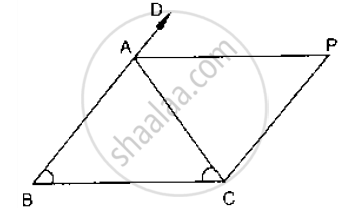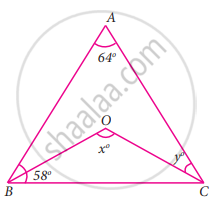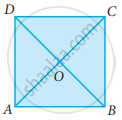Advertisements
Advertisements
Question
In a quadrilateral ABCD, ∠A + ∠C is 2 times ∠B + ∠D. If ∠A = 140° and ∠D = 60°, then ∠B=
Options
60°
80°
120°
80°
None of these
Solution
ABCD is a quadrilateral, with ∠A +∠C = 2(∠B + ∠D) .
By angle sum property of a quadrilateral we get:
∠A +∠B +∠C +∠D = 360°
(∠A +∠C )+(∠B +∠D) = 360°
But,we have ∠A+∠C = 2(∠B +∠D)
2(∠A + ∠C = 360°
∠A + ∠C = 120°
Then,
∠B + ∠D = 60°
The two equations so formed cannot give us the value for ∠B with a given value of ∠A .
Hence the correct choice is (d).
APPEARS IN
RELATED QUESTIONS
In a parallelogram ABCD, determine the sum of angles ∠C and ∠D .
The sides AB and CD of a parallelogram ABCD are bisected at E and F. Prove that EBFD is a parallelogram.
In Fig. below, AB = AC and CP || BA and AP is the bisector of exterior ∠CAD of ΔABC.
Prove that (i) ∠PAC = ∠BCA (ii) ABCP is a parallelogram

In a parallelogram ABCD, if ∠A = (3x − 20)°, ∠B = (y + 15)°, ∠C = (x + 40)°, then find the values of xand y.
PQRS is a quadrilateral, PR and QS intersect each other at O. In which of the following case, PQRS is a parallelogram?
∠P = 100°, ∠Q = 80°, ∠R = 95°
The figure formed by joining the mid-points of the adjacent sides of a parallelogram is a
In the given figure, ∠A = 64°, ∠ABC = 58°. If BO and CO are the bisectors of ∠ABC and ∠ACB respectively of ΔABC, find x° and y°
In the given Figure, if AB = 2, BC = 6, AE = 6, BF = 8, CE = 7, and CF = 7, compute the ratio of the area of quadrilateral ABDE to the area of ΔCDF. (Use congruent property of triangles)
ABCD is a square, diagonals AC and BD meet at O. The number of pairs of congruent triangles with vertex O are
Prove that the quadrilateral formed by the bisectors of the angles of a parallelogram is a rectangle.
